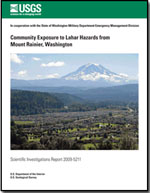Community exposure to lahar hazards from Mount Rainier, Washington
Links
- More information: USGS Index Page (html)
- Download citation as: RIS | Dublin Core
Abstract
Geologic evidence of past events and inundation modeling of potential events suggest that lahars associated with Mount Rainier, Washington, are significant threats to downstream development. To mitigate potential impacts of future lahars and educate at-risk populations, officials need to understand how communities are vulnerable to these fast-moving debris flows and which individuals and communities may need assistance in preparing for and responding to an event. To support local risk-reduction planning for future Mount Rainier lahars, this study documents the variations among communities in King, Lewis, Pierce, and Thurston Counties in the amount and types of developed land, human populations, economic assets, and critical facilities in a lahar-hazard zone. The lahar-hazard zone in this study is based on the behavior of the Electron Mudflow, a lahar that traveled along the Puyallup River approximately 500 years ago and was due to a slope failure on the west flank of Mount Rainier. This lahar-hazard zone contains 78,049 residents, of which 11 percent are more than 65 years in age, 21 percent do not live in cities or unincorporated towns, and 39 percent of the households are renter occupied. The lahar-hazard zone contains 59,678 employees (4 percent of the four-county labor force) at 3,890 businesses that generate $16 billion in annual sales (4 and 7 percent, respectively, of totals in the four-county area) and tax parcels with a combined total value of $8.8 billion (2 percent of the study-area total). Employees in the lahar-hazard zone are primarily in businesses related to manufacturing, retail trade, transportation and warehousing, wholesale trade, and construction. Key road and rail corridors for the region are in the lahar-hazard zone, which could result in significant indirect economic losses for businesses that rely on these networks, such as the Port of Tacoma. Although occupancy values are not known for each site, the lahar-hazard zone contains numerous dependent-population facilities (for example, schools and child day-care centers), public venues (for example, religious organizations and hotels), and critical facilities (for example, police and fire stations). The lahar-hazard zone also includes high-volume tourist sites, such as Mount Rainier National Park and the Puyallup Fairgrounds. Community exposure to lahars associated with Mount Rainier varies considerably among 27 communities and four counties—some may experience great losses that reflect only a small portion of their community and others may experience relatively small losses that devastate them. Among 27 communities, the City of Puyallup has the highest number of people and assets in the lahar-hazard zone, whereas the communities of Carbonado, Fife, Orting, and Sumner have the highest percentages of people and assets in this zone. Based on a composite index, the cities of Puyallup, Sumner, and Fife have the highest combinations of the number and percentage of people and assets in lahar-prone areas.
Study Area
| Publication type | Report |
|---|---|
| Publication Subtype | USGS Numbered Series |
| Title | Community exposure to lahar hazards from Mount Rainier, Washington |
| Series title | Scientific Investigations Report |
| Series number | 2009-5211 |
| DOI | 10.3133/sir20095211 |
| Year Published | 2009 |
| Language | English |
| Publisher | U.S. Geological Survey |
| Contributing office(s) | Cascades Volcano Observatory, Volcano Hazards Program |
| Description | iv, 27 p. |
| Country | United States |
| State | Washington |
| Other Geospatial | Mount Rainier |
| Online Only (Y/N) | Y |


